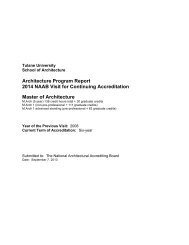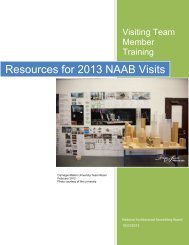Architecture Program Report Tulane University New Orleans ...
Architecture Program Report Tulane University New Orleans ...
Architecture Program Report Tulane University New Orleans ...
Create successful ePaper yourself
Turn your PDF publications into a flip-book with our unique Google optimized e-Paper software.
As has been noted in the section “3.9. Information Resources,” there are<br />
multiple archives within the School, <strong>University</strong>, and the City of <strong>New</strong> <strong>Orleans</strong><br />
that feature the architecture, landscape and urban design of the region.<br />
Most notably, <strong>Tulane</strong> <strong>University</strong> houses the world-renowned Southeastern<br />
Architectural Archives, an extensive collection of drawings and documents<br />
associated with national and regional traditions. Students are introduced to<br />
this material as a substantial aspect of the educational environment at<br />
<strong>Tulane</strong>. In addition, the History Department at <strong>Tulane</strong> <strong>University</strong> has a<br />
number of courses pertaining to local and regional traditions, and there are<br />
ample electives in the curriculum for students to take these courses.<br />
11. Use of Precedents<br />
Ability to incorporate relevant precedents into architecture and urban design<br />
projects.<br />
The use of programmatic and formal precedents in conceptualization and<br />
development of architecture and urban design projects is diffuse<br />
throughout the Design Studio sequence—including not only the required<br />
core studio sequence, but most of the upper-level studios as well. In<br />
addition, the use of precedents is a substantial component of Pre-thesis<br />
research and Thesis Studio (DSGN 510, 520). It is also a significant<br />
component of theoretical and historical critique within the History/Theory<br />
(AHST) sequence as well as in the required Technology (Technological<br />
Systems and Integrated Technologies) components of the curriculum<br />
(ATCS).<br />
It is the position of the School of <strong>Architecture</strong> that the ability to engage and<br />
critically assess precedents is a fundamental component of design<br />
research and development. The extensive History/Theory components of<br />
the curriculum underscore this belief; in general, Design Studio course<br />
problems begin with an intense focus on precedents and the relationship<br />
between precedent analysis and design. The required Case Studies<br />
component of the DSGN 320 course (AHST 420) in fact focuses on<br />
precedents and the analysis thereof as the ‘ground’ for architectural inquiry.<br />
It is understood that precedents—a significant component of the body of<br />
knowledge that is architecture—form the foundation of the discipline, in<br />
particular the language and history (and theory as a subset of history) of<br />
the discipline. However, it is also understood that precedents not be only<br />
“historical,” but can exist within the contemporary forum of architectural<br />
design. Both Professor Gamard’s History/Theory I required elective (AHST<br />
410) and Professor Owen’s required History/Theory I elective “Herzog and<br />
de Meuron, Moneo, Machado-Silvetti, Koolhaas: Theorizing the Real in<br />
Contemporary Practice (AHST 411)” approach several architects and their<br />
respective architectural work as contemporary precedents.<br />
It should be noted that Technology courses also place a premium on the<br />
use of precedents, including ATCS 110 (“Introduction to Technology: the<br />
Tectonic and Stereotomic”), Technologies II (ATCS 310), and Technologies<br />
III (ATCS 320) (“Systems Integration”).<br />
Additional opportunities are located in both the AVSM (Visual Studies) and














